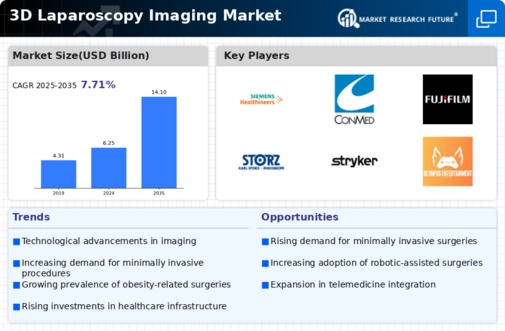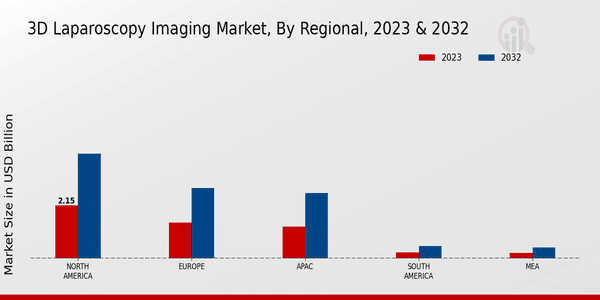Market Growth Projections
The Global 3D Laparoscopy Imaging Market Industry is projected to experience substantial growth over the next decade. With a market value anticipated to reach 14.1 USD Billion by 2035, the industry is on a promising trajectory. The compound annual growth rate (CAGR) of 7.71% from 2025 to 2035 indicates a robust expansion phase. This growth is driven by various factors, including technological advancements, rising demand for minimally invasive surgeries, and increased healthcare investments. The market's evolution reflects broader trends in healthcare, emphasizing the importance of innovative imaging solutions in surgical practices.
Technological Advancements in Imaging
The Global 3D Laparoscopy Imaging Market Industry is experiencing a surge in technological advancements, particularly in imaging techniques. Innovations such as high-definition cameras and enhanced visualization systems are improving surgical outcomes. For instance, the integration of augmented reality in laparoscopic procedures allows surgeons to visualize internal structures more clearly, thereby increasing precision. This technological evolution is expected to contribute significantly to the market's growth, with projections indicating a market value of 6.25 USD Billion in 2024. As these technologies continue to evolve, they are likely to attract more healthcare facilities to adopt 3D laparoscopy imaging solutions.
Growing Prevalence of Chronic Diseases
The Global 3D Laparoscopy Imaging Market Industry is significantly influenced by the growing prevalence of chronic diseases such as obesity, diabetes, and cancer. These conditions often require surgical interventions, which are increasingly performed using 3D laparoscopic techniques. The ability to conduct complex surgeries with greater accuracy and less trauma is appealing to both patients and healthcare providers. As the global population ages and the incidence of these diseases rises, the market is expected to expand. The compound annual growth rate (CAGR) of 7.71% from 2025 to 2035 indicates a robust growth trajectory driven by these factors.
Surge in Awareness and Training Programs
The Global 3D Laparoscopy Imaging Market Industry is also experiencing a surge in awareness and training programs aimed at educating healthcare professionals about the benefits of 3D imaging technologies. As surgical teams become more familiar with these advanced techniques, the adoption rate is likely to increase. Educational initiatives and workshops are being organized globally to enhance the skills of surgeons and operating room staff. This growing knowledge base is expected to facilitate the integration of 3D laparoscopic imaging into standard surgical practices, contributing to the market's projected growth.
Rising Demand for Minimally Invasive Surgeries
The Global 3D Laparoscopy Imaging Market Industry is witnessing an increasing demand for minimally invasive surgeries. Patients and healthcare providers are increasingly favoring procedures that reduce recovery time and minimize scarring. The enhanced visualization provided by 3D imaging technologies facilitates complex surgical procedures, making them safer and more efficient. This trend is reflected in the projected market growth, with an anticipated value of 14.1 USD Billion by 2035. As more surgeons adopt these techniques, the demand for advanced imaging solutions is likely to rise, further propelling the market forward.
Increased Investment in Healthcare Infrastructure
The Global 3D Laparoscopy Imaging Market Industry benefits from increased investment in healthcare infrastructure across various regions. Governments and private entities are allocating substantial funds to enhance surgical facilities and adopt advanced technologies. This investment is particularly evident in developing countries, where improving healthcare access is a priority. As hospitals upgrade their equipment to include 3D laparoscopic imaging systems, the market is poised for growth. The anticipated market value of 6.25 USD Billion in 2024 underscores the potential for expansion driven by these infrastructural improvements.



















